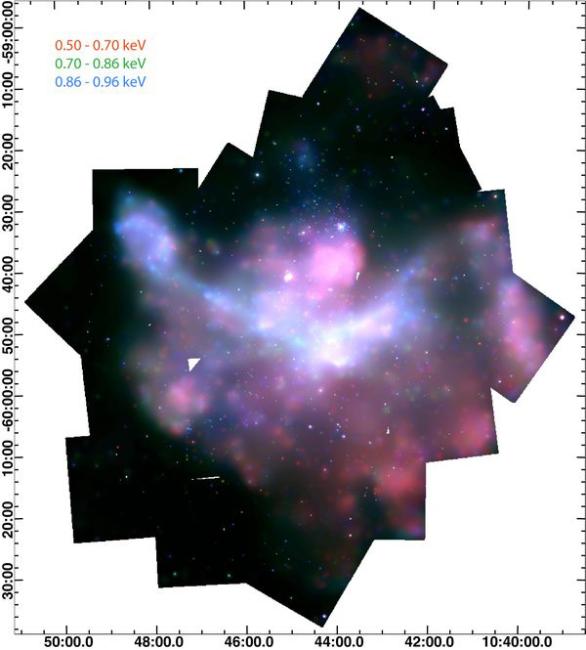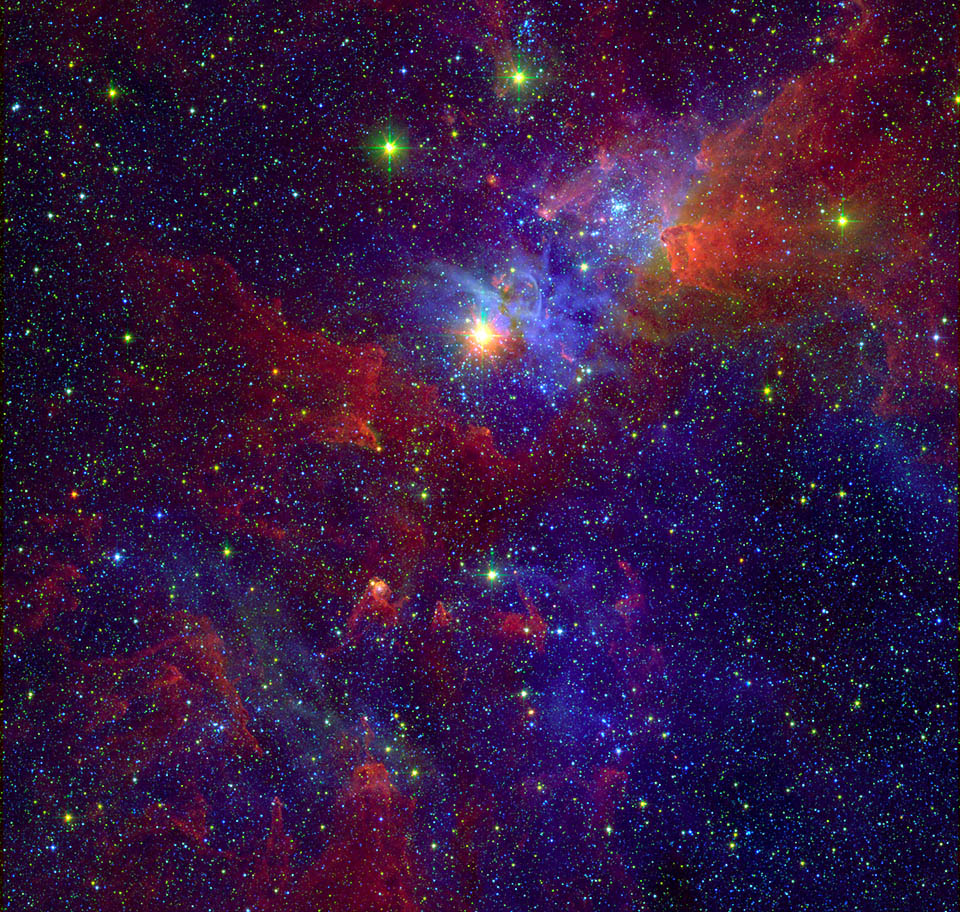Smithsonian Astrophysical Observatory
Weekly Science Update | 2011 May 13
The Chandra Carina Complex Project (CCCP):The Great Nebula in the constellation of Carina is a massive star-forming complex located about 7.5 thousand light-years away. The main star in the complex, Eta Carinae, shines brightly in the southern sky. Its ensemble of stellar clusters are young and hot, with ages that range from less than about one million years to about six million years. Altogether, the region contains one of the richest concentrations of massive young stars in the galaxy. In addition, the region is rich in non-stellar material including filaments, pillars, cavities, arcs, and other features indicative of a turbulent and complex history.
- A false-color image of the X-ray emission from the massive cluster of hot young stars around the Eta Carinae Nebula. In addition to thousands of points corresponding to hot stars, the image shows that hot gas is widely distributed. The three colors correspond to three energy bands of X-rays, as labeled in the caption. Notation on the frame edges provides the sky location. (Credit: Chandra X-ray Observatory)
The Nebula is not only rich in hot sources. It is also full of mysteries because the numerous complex structures have proven difficult to explain. Some scientists think there has been an early epoch of active star formation in the region, and whether or not a supernova may have gone off in the neighborhood (and so generated some of the observed structures) is actively debated. The role of intense shocks and colliding winds in generating the hot diffuse gas that is seen is also controversial.
A large team of CfA astronomers and their colleagues has used the Chandra X-ray Observatory to study the Great Nebula in Carinae, integrating new data with older observations from the Chandra archives. They have begun publishing a landmark set of sixteen papers on the region and its rich astrophysical contents, including separate studies of its massive stars, intermediate mass stars, and low mass stars, magnetic field effects, and the infrared characteristics of its dust enshrouded sources.
One of the new papers examines the X-ray emission from the hottest, most massive stars in the cluster, of which 68 (of the 70 known) were detected in this study. It has long been thought that shocks from powerful winds produce X-ray emission; this is in contrast to smaller stars whose photospheres can produce X-ray emission. This new study finds that there appear to be at least three different kinds of shocks at work: those embedded in the stellar wind, others due to collisions between the winds from two massive stars that orbit each other in a binary pair, and shocks produced when magnetically channeled winds from the opposite hemispheres of a star meet and collide. Other results of this survey include a catalog of over 14,000 X-ray point sources, mostly stars. The set of new papers represents a basic reference for understanding this famous beacon in the southern sky and the mechanisms at work generating stellar X-rays.
A Special Issue of The Astrophysical Journal Supplement Series
(Volume 194, Number 1, May 2011)
- An Introduction to the Chandra Carina Complex Project - LK Townsley et al
- A Catalog of Chandra X-ray sources in the Carina Nebula - PS Broos et al
- Source Contamination in X-ray Studies of Star-forming Regions: Application to the Chandra Carina Complex Project - KV Getman et al
- A Naive Bayes Source Classifier for X-ray Sources - PS Broos et al
- Carina OB Stars: X-ray Signatures of Wind Shocks and Magnetic Fields - M Gagné et al
- Candidate X-ray-emitting OB Stars in the Carina Nebula Identified Via Infrared Spectral Energy Distributions - MS Povich et al
- Global X-ray Properties of the O and B Stars in Carina - Y Nazé et al
- X-ray Emission from the Double-binary OB-star System QZ Car (HD 93206) - ER Parkin et al
- X-ray Star Clusters in the Carina Complex - ED Feigelson et al
- Near-infrared Properties of the X-ray-emitting Young Stellar Objects in the Carina Nebula - T Preibisch et al
- A Chandra ACIS Study of the Young Star Cluster Trumpler 15 in Carina and Correlation with Near-infrared Sources - J Wang et al
- The Chandra Carina Complex Project View of Trumpler 16 - SJ Wolk et al
- The Search for Low-mass Companions of B Stars in the Carina Nebula Cluster Trumpler 16 - NR Evans et al
- A Pan-Carina Young Stellar Object Catalog: Intermediate-mass Young Stellar Objects
in the Carina Nebula Identified Via Mid-infrared Excess Emission - MS Povich et al - The Chandra Carina Complex Project: Deciphering the Enigma of Carina's Diffuse X-ray Emission - LK Townsley et al
- The Integrated Diffuse X-ray Emission of the Carina Nebula Compared to Other Massive Star-forming Regions - LK Townsley et al

